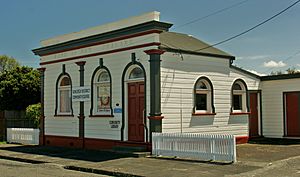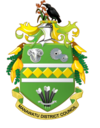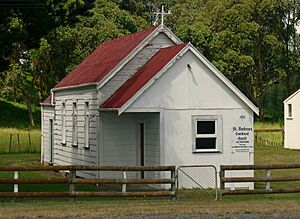Manawatū District facts for kids
Quick facts for kids
Manawatū District
|
||
|---|---|---|
|
Territorial authority district
|
||

Rongotea Community Centre and Library (2011)
|
||
|
||
 |
||
| Country | New Zealand | |
| Region | Manawatū-Whanganui | |
| Wards | Feilding Rural |
|
| Seat | Feilding | |
| Area | ||
| • Land | 2,566.59 km2 (990.97 sq mi) | |
| Population
(June 2023)
|
||
| • Total | 33,900 | |
| Time zone | UTC+12 (NZST) | |
| • Summer (DST) | UTC+13 (NZDT) | |
The Manawatū District is a special area in the North Island of New Zealand. It's like a county or region, managed by the Manawatū District Council. This district covers most of the land between the Manawatū River in the south and the Rangitīkei River in the north.
It stretches from near Himatangi in the south to just south of Mangaweka in the north. To the east, it reaches the Ruahine Range. The main town in the district is Feilding. The total area of the Manawatū District is about 2,624 square kilometers.
Contents
What's in a Name? The Manawatū Story
The name Manawatū has a cool story from Māori history. It's said that a famous Māori explorer named Hau gave the river its name. He was chasing his wife along the coast of the North Island. As he traveled, he named many river mouths based on what happened to him.
When he reached the wide Manawatū River, he was amazed and a bit scared he couldn't cross it. He said, "Ka tū taku manawa," which means "My heart stands still." This is how the river and the area got their name.
The name Manawatū can also mean the wider area around the Manawatū Plains. This is the flat land around the Manawatū River, with Palmerston North as its biggest city. The exact borders of this wider Manawatū area aren't always clear. But it usually includes Palmerston North, all of today's Manawatū District, and parts of the Horowhenua District.
Who Lives Here? The People of Manawatū
Manawatū District covers about 2,566 square kilometers. As of 2023, around 32,415 people live here. This means there are about 12.6 people for every square kilometer.
Feilding is the biggest town and where the council is located. It has about 17,000 people. Other smaller towns and settlements in the district include Halcombe, Himatangi Beach, Kimbolton, Pohangina, Rongotea, Sanson, and Tangimoana.
Population Changes Over Time
The number of people living in Manawatū District has grown steadily:
- 2006: 26,070 people
- 2013: 27,459 people
- 2018: 30,165 people
- 2023: 32,415 people
This shows that the district has become more popular, with about 7.5% more people since 2018.
A Mix of Cultures
The people in Manawatū District come from many different backgrounds. Based on the 2023 census:
- Most people (88.0%) are of European or Pākehā background.
- About 18.3% are Māori.
- Smaller groups include Pasifika (2.8%), Asian (3.4%), and others.
- Many people identify with more than one ethnicity.
About 10.6% of the people living here were born outside New Zealand.
Age and Work
The average age of people in Manawatū District is about 41 years old.
- About 20% of the population is under 15 years old.
- About 19.5% are 65 years or older.
Many people work full-time (about 51.6%), while others work part-time (14.6%). A small number (3.0%) are looking for work.
Things to Do in Manawatū District
The Manawatū District has a mix of flat plains and rolling hills. It's a great place for outdoor activities.
- Cycling and Views: Cyclists love the area for its clear views of the volcanoes in the Central North Island.
- Beaches and Dunes: The western coast has nice swimming beaches and huge sand dunes.
- Hiking: In the east, the Ruahine Ranges offer walking tracks and amazing views from places like Wharite mountain.
Feilding: The Heart of the District
In the middle of the district is Feilding, a lively town with lots to see and do:
- Saleyards: Feilding is famous for its busy livestock saleyards.
- Manfeild: This is a popular place for horse riding events and motorsport races.
- Shopping: You can find unique shops and boutiques.
- History: The town has many historical buildings and collections that tell its story.
RNZAF Base Ohakea
The main base for the Royal New Zealand Air Force, called RNZAF Base Ohakea, is also located in the Manawatū District.
Schools in Manawatū District
The district has several schools for young people:
- Feilding High School in Feilding
- Hato Paora College in Cheltenham
See also
 In Spanish: Distrito de Manawatu para niños
In Spanish: Distrito de Manawatu para niños



